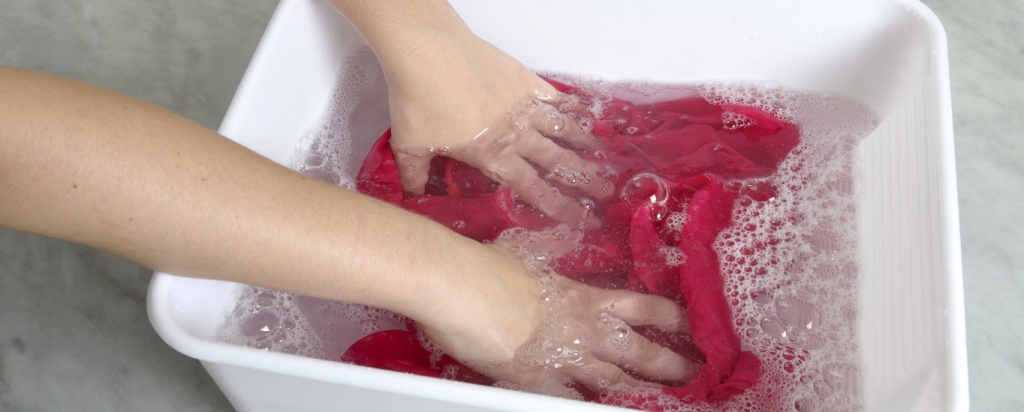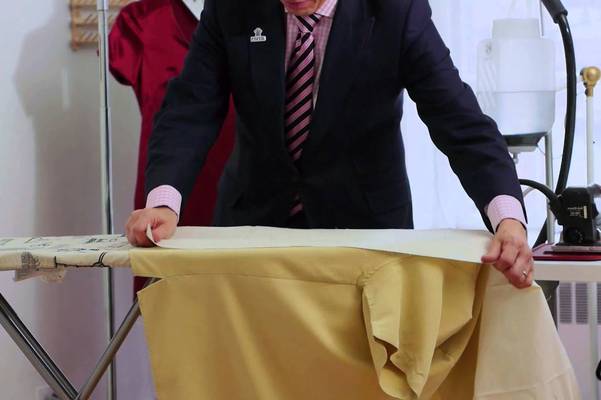
How to wash viscose by hand and in a washing machine
Viscose is a wonderful material that is widely used in the production of clothing and other textiles. Made from natural cellulose, viscose has such qualities as lightness, softness to the touch, things from it are worn well, but require careful handling. This is a delicate fabric that needs to be washed following strict rules and recommendations. From this article, you will learn whether such material can be washed in an automatic machine, how to dry it, whether it is permissible to iron it, what to do if the fabric has stretched or shrunk, how to avoid this, and a lot of other useful information.

General recommendations for the care of viscose products
Viscose, being a delicate material, requires an appropriate attitude. Therefore, experts give several recommendations, which will help to care for products made from this material correctly:
-
If you wash clothes in a machine or semi-automatic machine, it is better to place them in a mesh bag.
-
You can not wash viscose products with other clothes (even matching in color), if it is made of a tougher, coarser fabric (with jeans, for example).
-
If the fabric is mixed, the content of viscose in it is small, washing should be carried out according to the rules for caring for the main type of fabric fibers.
-
Do not use substances such as vinegar, ammonia or medical alcohol for washing, stain removal, bleaching, especially in high concentrations.
-
For dyeing viscose products, you can use dyes designed for things made from natural fabrics — linen, cotton. Always test the dye on an inconspicuous area of the item before doing a full-scale processing.
-
For bleaching and stain removal, oxygen household chemicals can be used, they should not contain chlorine or similar aggressive components. It is better to consult with the manufacturer of the product beforehand, many companies have their own sites with online chats for feedback and advice.
Proper care of things made of viscose is a guarantee that they will last as long as possible and will not lose their aesthetic characteristics.
Is it possible to wash viscose in the machine
We will immediately answer — it is possible, but under certain conditions. If the temperature regime is not observed, the fabric may shrink or, on the contrary, stretch, deform, or even completely become unusable.
Preparation for washing viscose products:
-
First of all, carefully study the tag that is on the product. There may be comprehensive recommendations regarding the care of clothing made from this material. If they are, stick to them, if not, follow the recommendations that you will find in this material.
-
Check pockets. Any sharp, heavy objects, such as hairpins, coins, keys, can cause irreparable damage to the fabric during washing and spinning. If pockets can be zipped, do so.
-
Fasten all existing fasteners, zippers, buttons.
-
Turn the product inside out.
-
Sort things. Do not wash white, color and black/dark in one load.
Features of washing viscose:
-
This is a delicate material, so you need to set a gentle wash cycle. It can be a “delicate”, “hand wash”, “wool” or “silk” mode.
-
Regarding the washing temperature — viscose does not tolerate water temperatures above 30 degrees. If made hot, things may shrink.
-
We turn off the spin cycle so that during intense exposure the fabric does not deform.
-
Choice of detergent. It should be such a powder, or better, a liquid gel that dissolves perfectly in cold water. It should also have sufficient efficiency at a temperature of 30 degrees. It is better to opt for gels for washing delicate fabrics.
-
Should I use fabric softener to wash viscose? It is possible, but not necessary. Such a tool will make things softer. And since many viscose products are “wearable” garments, you will enjoy wearing them if they are soft and silky.
-
Extra rinse. It is also desirable, but not required, especially if a liquid hypoallergenic detergent is used.
-
You do not need to dry things in an automatic dryer. Just wring them out with your hands without twisting, hang them on the dryer so that the moisture evaporates naturally, it won’t take long.
As you can see, caring for a viscose product using a washing machine is not difficult. We just set the most gentle mode — the clothes are perfectly washed, and at the same time there will be no risk of deformation.
How to wash viscose by hand

If you have the desire and ability to wash viscose products by hand, this will be the right decision. In this case, there is no risk of damage and deformation of the material at all. The procedure is as follows:
-
Pour cool water into a container (basin, bath, pan). If it is possible to measure the temperature of the liquid, it should be no higher than 30 degrees. But it can also be determined approximately, “by touch”.
-
Dissolve detergent in water. If it was still possible to use dry powder in an automatic type washing machine, then it is categorically not recommended to do this with hand washing, since it simply will not dissolve, because the washing cycle will not be intense, and the water is not warm enough for this. Therefore, we take a liquid detergent for washing delicate fabrics. If it’s meant for washing machines, that’s okay, you can still use it without damaging the fabric or skin of your hands.
-
Immerse things in a container, press them to the bottom, the water should completely cover them, there should still be a couple of centimeters of liquid on top. Slightly three and mnem. We leave for 30-60 minutes.
-
Wash viscose products with soft, massaging, not rubbing movements. Press with your palms, squeezing, but not twisting things.
-
Rinse in several changes of water or running water until the foam disappears completely. At the very end of the procedure, the water flowing from the thing should be completely transparent.
After washing and rinsing, once again finally wring out the items with your hands without twisting them. Shake lightly, hang so that the water drains freely, you do not need to use clothespins, they can leave marks on the fabric. It is better to dry the material in the shade in the open air or in a well-ventilated area. Things made of viscose are not placed on the battery or other heating devices for drying. Even better is to spread the clothes on a terry towel spread over the dryer rails. In this case, moisture will be absorbed into the towel and partially evaporate, the number of folds will be minimal, and creases will not appear at all.
How to wash viscose so that it sits
Sometimes it happens that for various reasons things made of viscose are stretched. This happens more often if the clothes are not made from pure viscose, but from mixed fabrics, when the composition contains not only viscose, but also fibers of other types. It is theoretically possible to make a thing “sit down” by 1 or 2 sizes. However, before proceeding with the procedure, you must understand that the result of such an experiment may not only be unexpected, but also very undesirable. If the thing is expensive or valuable, it is better to take it to a dry cleaner, where experts will tell you exactly whether it is possible to make it sit down and perform the appropriate manipulations without the risk of damaging the product.
Viscose «shrinks» when in contact with high temperature water. It is enough to heat the liquid to 50 degrees, immerse the thing in it for 10 minutes (without adding washing powder), wring it out slightly, leave it to dry in a straightened state on a terry towel.
If you have a product not from pure viscose, but from a blended fabric, it can be washed in a machine so that it sits down. Consider the optimal conditions for fabrics of different types:
-
Viscose + cotton. Wash at a temperature of 50-55 degrees, wring out at 400 rpm, then dip in hot water (50+) with air conditioning for another 10 minutes, dry in heat, in the sun.
-
Viscose + synthetic. Wash at a temperature of 45-50 degrees, wring out at 600 rpm, rinse in cold water, wring out again with your hands or at minimum speed.
-
Viscose + wool. Wash at a temperature of 50 degrees, spin at 400 rpm, rinse in cold water, leave there for 5 minutes, gently wring out with your hands again, straighten it on a horizontal surface, there should be air access from below.
None of these methods gives a guaranteed positive result. Things are made from fabrics with different contents of viscose and other fibers, so it is impossible to know in advance how the material will behave. But if you’re willing to take the risk, exposure to high and contrasting temperatures should help the piece shrink.
How to wash to stretch the product
If the thing after washing still sat down, and you want to stretch it to normal sizes, you can use one method with a folk recipe. However, here, too, it must be borne in mind that the result may not please. If you still intend to take the risk, here is the sequence of actions:
-
Pour 3-5 liters of water into the container in which you intend to soak the viscose thing.
-
Pour in 1 tablespoon of 3% hydrogen peroxide, mix thoroughly.
-
Immerse the thing, leave to soak for 15-20 minutes.
-
Press the product without twisting it.
-
Stretch the thing a little, holding it by the edges, straightening the fabric from the center to the edges, acting as gently as possible.
-
Put the thing on yourself, move, stretching it on the body. Do not remove clothes until completely dry.
After that, you can try to stretch the product even more, if necessary. To do this, use an iron with a steamer. Steam is directed to a certain part of the thing, stretching it in the right direction with the help of hand movements.
Drying and ironing products

As already mentioned, the optimal conditions for drying viscose fabrics are in a horizontal position, on a terry towel, on a dryer around which there is air circulation. Do not dry things: in the sun; on or near the battery; in an automatic dryer. What about ironing? You can iron such material by observing simple rules:
-
Fast.
-
at the lowest possible temperature.
-
From the wrong side.
-
Through a layer of pure cotton white cloth.
-
Without the use of steam (steam is used to stretch or shrink the product).
If the wrinkles and creases in the fabric are very visible and do not lend themselves to normal ironing, the fabric can be slightly moistened using clean water from a spray bottle.
Добавить комментарий
Для отправки комментария вам необходимо авторизоваться.